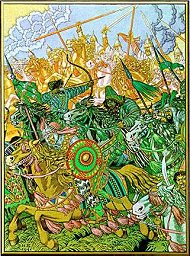
Sacred Texts Legends/Sagas
Buy this Book at Amazon.com

 |
The Tale of the Armament of Igorby Leonard A. Magnus[1915] |
Then Igor gazed up at the bright sun, and saw all his warriors covered with the darkness [that proceeded] out of it. And Igor said to his druzhina:--"Brothers and druzhina! Better is it to be hewn to pieces than to be captive! So let us mount, brothers, on our swift steeds and look upon the blue Don!"
The Story of Igor is a long Russian ballad from the 12th century. This work is often referred to simply as the Slovo, the Tale (from its Russian title Slovo o pol'ku Igoreve). In the 12th century Russia was a small feuding group of city states, without central authority or cohesion. Fifty years hence, the Mongolians would roll over the Russians and rule them with an iron fist for two centuries. But at that time the most persistent enemies of the Russians were the fierce Polovtsi nomads. They roamed the wide grassy plains of the Don and Dnepr down to the inland seas, to the south of Russian territory. In 1185 a minor skirmish between the Polovtsi and Igor Svyatoslavich, a noble of Chernigov, a city in what it today the Ukraine, was immortalized in this poem.
This was not a strategic battle: Igor had marched with his brothers on a grudge, having been excluded from a larger expedition, and the encounter with the enemy was purely impromptu. Nor was it a victory: Igor was wounded and captured in battle, later escaping to walk back to Chernigov. Out of this incident, however, was built one of the first treasures of Russian literature. There are vivid natural metaphors, the evocation of Slavic pagan deities, and the stirring description of combat. There an appeal for Russian national unity, as the poet pleads for each of the factions to support Igor in his hour of need. Even more striking is the fact that we know nothing about the author of the Slovo, other than that he was a contemporary of the events he wrote about--perhaps even a witness.
The Slovo was discovered in 1795 in a bundle of manuscripts purchased from a monastery. It was published in 1800, although most of the print run was destroyed along with the original manuscript in 1812 during the fire which the retreating forces of Napoleon set to Moscow. There have always been nagging doubts about the authenticity of the poem, because no other manuscript of it has ever been found. Some have speculated that this may be because of the explicit pagan beliefs in the Slovo, which may have led the Church to quietly shelve it. It would be nearly impossible to forge this text, as it is written in very archaic Russian which has stood up to modern linguistic studies.
The 19th century opera Prince Igor, by Bordin and Rimsky-Korsakov was based on the Slovo. An excerpt from this opera, the orchestral Polovetsian Suite is a staple in the 'pops classical' repertoire.
This, the Magnus translation, is the only public domain English translation of the Slovo, and it makes its first appearance on the Internet at this site; it is long out of print and hard to obtain. There is a notable 1960 translation by Vladimir Nabokov, the author of Lolita (see box on the right), which is currently out of print but available used in at least two editions. Nabokov describes Magnus' work as "a bizarre blend of incredible blunders, fantastic emendations, erratic erudition and shrewd guesses." However, as this is the only one currently in the public domain in the US, it will have to suffice. Among the features of this edition are a dozen genealogical charts of the Russian noble families of the period, which Nabokov considered very helpful in preparing his translation.
Production notes: Your browser must be configured to view Unicode: refer to the sacred-texts Unicode help file if you have trouble. Unfortunately, due to the limitations of current optical character recognition technology, I had to omit about seventy pages of end notes.
--John Bruno Hare, May 11, 2006.